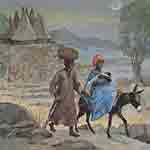
Then Joseph got up, took the child and his mother by night, and went to Egypt, and remained there until the death of Herod. This was to fulfil what had been spoken by the Lord through the prophet, ‘Out of Egypt I have called my son.’ (Matthew 2:14-15)
Ὁ δὲ ἐγερθεὶς παρέλαβεν τὸ παιδίον καὶ τὴν μητέρα αὐτοῦ νυκτὸς, καὶ ἀνεχώρησεν εἰς Αἴγυπτον
καὶ ἦν ἐκεῖ ἕως τῆς τελευτῆς Ἡρώδου ἵνα πληρωθῇ τὸ ῥηθὲν ὑπὸ τοῦ Κυρίου διὰ τοῦ προφήτου λέγοντος, Ἐξ Αἰγύπτου ἐκάλεσα τὸν υἱόν μου
the child and his mother – this lovely image is repeated
by night – the impression given is that it is immediately upon having received the message in the dream. It is also secretively. In the dark.
Death of Herod – we know Herod the Great died in 4BC. The current dating system was invented by Dionysius Exiguus of Scythia Minor in 525. It took some centuries to become accepted widely. We use AD Anno Domini – the Year of Our Lord. Zero, of course, is a modern concept. The year prior to 1 AD is 1 BC (Before Christ). Dionysius was producing Easter dating tables and didn’t want to continue memorialise the emperor Diocletian who was so cruel to Christians and whose years had been used in an Easter dating.
Dionysius writes that it was “525 years … since the incarnation of the Lord”. There is no clarity whether, in his mind, the “incarnation of the Lord” refers to the conception or to the nativity.
In any case, those who remember the celebration of the start of the Year 2000, as if it were the end of one millennium and the start of another, will now realise that we celebrated in the wrong year! Even if we pretend that the incarnation happened at the start of 1 AD, only 9 years had passed at the start of 10 AD, only 999 years had passed at the start of 1,000 AD, and only 1,999 years had passed at the start of 2000. The celebration assumed there was a zero year – which there wasn’t.
When Jesus was actually born depends on your acceptance of the historicity of this Matthew story. Herod the Great died in 4 BC, giving a common dating of Jesus’ birth to be around 6 or 7 BC.
This was to fulfil what had been spoken by the Lord through the prophet, ‘Out of Egypt I have called my son.’ – Hosea 11:1 has
כִּי נַעַר יִשְׂרָאֵל וָאֹהֲבֵהוּ וּמִמִּצְרַיִם קָרָאתִי לִבְנִֽי׃
Matthew’s text is a translation of this Hebrew, surprisingly, rather than a quote of the Septuagint (which he normally follows):
διότι νήπιος Ισραηλ καὶ ἐγὼ ἠγάπησα αὐτὸν καὶ ἐξ Αἰγύπτου μετεκάλεσα τὰ τέκνα αὐτοῦ
which has “children” in the plural, rather than the Hebrew “son”.
In Hosea, of course, this is not a prophecy but a description of the Hebrew people called out of Egypt. So Matthew has here turned history into a prophecy.
Furthermore, Matthew reverses the direction of the quote. Hosea has God’s son coming out of Egypt – Matthew has Jesus going in to Egypt!
This is the twentyfirst post in a series – you can begin here:
Matthew in Slow Motion 1
Matthew in Slow Motion 2
Matthew in Slow Motion 3
Matthew in Slow Motion 4
Matthew in Slow Motion 5
Matthew in Slow Motion 6
Matthew in Slow Motion 7
Matthew in Slow Motion 8
Matthew in Slow Motion 9
Matthew in Slow Motion 10
Matthew in Slow Motion 11
Matthew in Slow Motion 12
Matthew in Slow Motion 13
Matthew in Slow Motion 14
Matthew in Slow Motion 15
Matthew in Slow Motion 16
Matthew in Slow Motion 17
Matthew in Slow Motion 18
Matthew in Slow Motion 19
Matthew in Slow Motion 20
As this year the Sunday Gospel readings’ focus is on St Matthew’s Gospel, I thought I’d start some of my personal study and Lectio Divina with that Gospel. [NB. I am using ‘Matthew’ as a convenient term for the author of the first Gospel in the order of the Christian canon].
If you appreciated this post, do remember to like the liturgy facebook page, use the RSS feed, and sign up for a not-very-often email, …
image source: Flight into Egypt by JESUS MAFA



